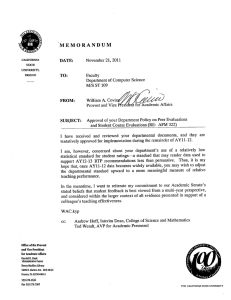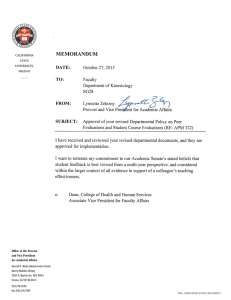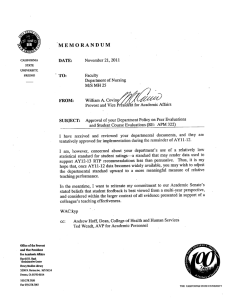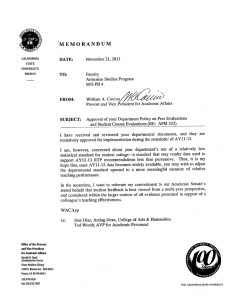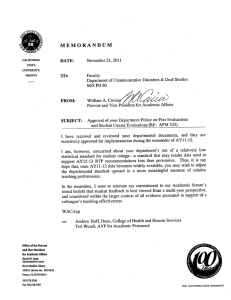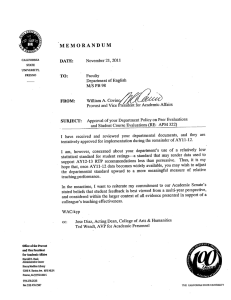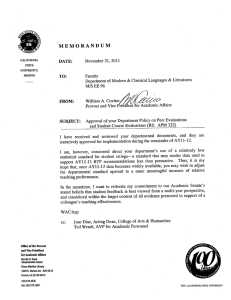MEMORANDUM
advertisement
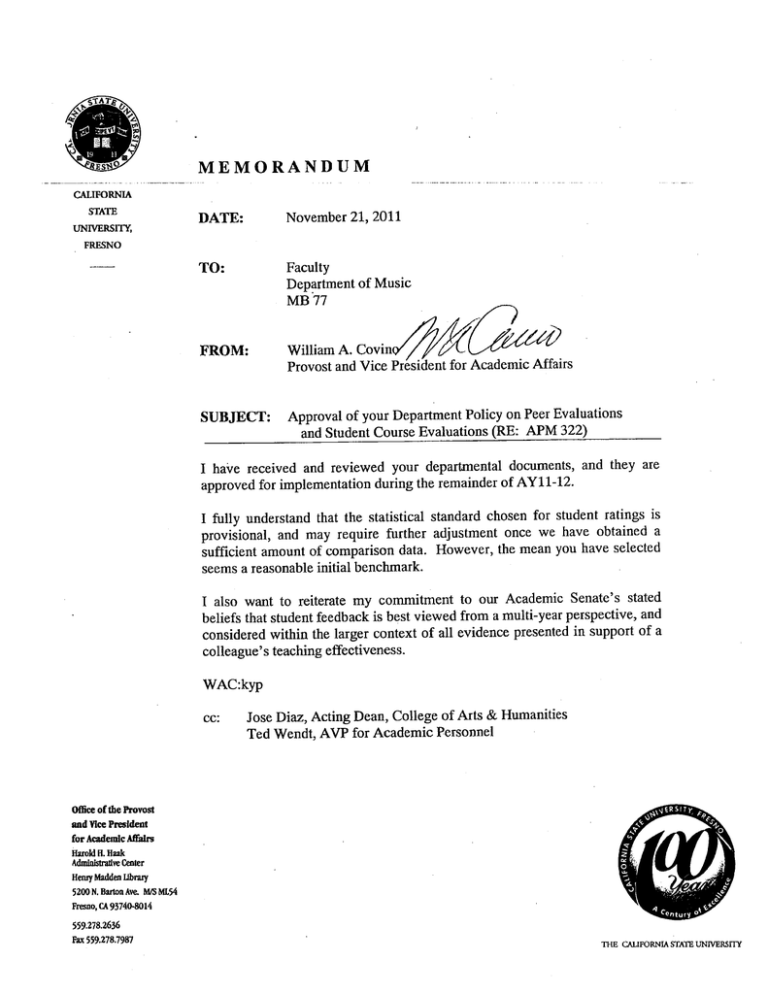
MEMORANDUM CALIFORNIA STATE UNIVERSITY, DATE: November 21, 2011 TO: Faculty Department of Music MB 77 FROM: William A. Covin Provost and Vice President for Academic Affairs FRESNO SUBJECT: Approval of your Department Policy on Peer Evaluations and Student Course Evaluations (RE: APM 322) I have received and reviewed your departmental documents, and they are approved for implementation during the remainder of AY11-12. I fully understand that the statistical standard chosen for student ratings is provisional, and may require further adjustment once we have obtained a sufficient amount of comparison data. However, the mean you have selected seems a reasonable initial benchmark. I also want to reiterate my commitment to our Academic Senate's stated beliefs that student feedback is best viewed from a multi-year perspective, and considered within the larger context of all evidence presented in support of a colleague's teaching effectiveness. WAC:kyp cc: Jose Diaz, Acting Dean, College of Arts & Humanities Ted Wendt, AVP for Academic Personnel Office of the Provost and Vice President for Academic Affairs Harold H. Haak Administrative Center Heruy Madden Library 5200 Pi. Barton Aw. WS ML54 Fresno, CA 93740-8014 559.278.2636 Fax 559.278.7987 THE CALIFORNIA STATE UNIVERSITY DEPARTMENT OF MUSIC POLICY ON ASSESSMENT OF TEACHING EFFECTIVENESS APM 322 is the official policy on the Assessment of Teaching Effectiveness. This Departmental policy is designed to further define requirements at the Departmental level as specified in APM 322. STUDENT RATINGS OF INSTRUCTION Each faculty member shall have a minimum of two sections rated by students annually. Probationary faculty will have all courses rated by students for the first two years of the probationary period. While the IDEA Short Form will be the standard paper instrument for the campus, faculty may elect to use either the Diagnostic Form or Online version. Student ratings of instruction shall be assessed to identify patterns and trends of teaching performance and effectiveness. It is expected that the faculty member shall meet or exceed the department standard 3.5 out of 5.0 using adjusted or unadjusted scores, whichever are higher, on a regular basis; however, it is more important to evaluate on the basis of multi-year trends rather than focusing on a single course or narrow time frame. PEER EVALUATIONS 1. Frequency a. For part-time temporary faculty, the first time a course is taught by the instructor and, thereafter, at least one section (to include as many different courses as possible) every other year of employment regardless of a break in service. b. For full-time temporary faculty, two sections (to include as many different courses as possible) each semester for the first year and two sections each academic year thereafter. c. For probationary faculty, two sections (to include as many different courses as possible) every semester. d. For tenured faculty, one section each academic year on a rotating basis such that during a five year period the maximum number of different courses is evaluated. e. For teaching associates, one course per semester. 2. Faculty will use the attached departmentally approved form to evaluate Course Content, Instructional Design, Instructional Delivery and Assessment methods. OVERALL The Department will follow the guidelines in APM 325, APM 327 and APM 328 when electing committees selected to prepare the overall evaluation of teaching. APPROVAL PROCESS Departmental policies will be submitted to the appropriate School/College Dean and to the Provost for review and approval. Last Updated: 09.20.2011 Approved by the Provost 09.21.11 APM 322b California State University, Fresno DEPARTMENT OF MUSIC PEER EVALUATION FORM Professor Evaluated: Rank: Term/Year: Course: Date of Classroom Visitation: Name of Evaluator Signature: Ratings Scale: 5 = superior I 4 = above average I 3 = average I 2 = below average I 1 = weak Category A. Course Content. The assessment of course content shall include a review of the Ratin g currency of the content of a course, the appropriateness of the level of the content of a course, and the appropriateness of the sequencing of the content to best achieve the learning objectives for the course. COMMENTS: B. Instructional Design. The assessment of the instructional design of the course shall include a review of learning objectives, syllabi, instructional support materials, organization of lectures, and the use of technology appropriate to the class. COMMENTS: C. Instructional Delivery. The assessment of delivery shall include a review of oral presentation skills, written communication skills, skills using various forms of informational technology, and the ability to create an overall environment conducive to student learning. Please use the Departmental Face-to-Face Peer Evaluation Form to assess instructional delivery. COMMENTS: SEE ATTACHED DEPARTMENTAL FACE-TO-FACE PEER EVALUATION FORM FOR COMMENTS D. Assessment Methods. The evaluation of assessment methods shall consist of a review of the tools, procedures, and strategies used for measuring student learning, and providing timely and meaningful feedback to students. COMMENTS: Additional comments may be included on the reverse side of this form. Approved by Department 09.20.2011/ Approved by the Provost 09.21.11 DEPARTMENT OF MUSIC Face-to-Face/Classroom Peer Evaluation Form Professor Evaluated Rank/Title Year & Term Course Visitation Date Room No Hour This appraisal form contains ten statements that relate to the teaching process. Rate each item, scoring 5 (highest) to 1 (lowest). Base reactions on the teaching process you witness during your visit to the classroom. Use an X (indicating "not applicable") when evidence is not available. 5 Superior 4 3 2 1 Above Average Average Below Average Weak Not Applicable 1. The class presentation was well-planned and organized. 2. Professor showed mastery of course content in materials presented. 3. Important ideas covered during the visit were clearly explained. 4. Professor encouraged critical thinking and analysis. 5. Professor reacted well to student views different from his/her own. 6. Students' attitudes in the class reflected acceptance of the professor's materials and methods used in the presentation. 7. Professor successfully engaged the students in the class. 8. Professor provided a challenging and meaningful experience. 9. The professor's pedagogical approach fit well with subject matter. 10. Overall atmosphere (including materials and student participation) was conducive to student learning. Evaluator Signature Print Name OVER Comments: Updated 10.04.11
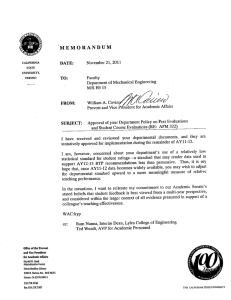
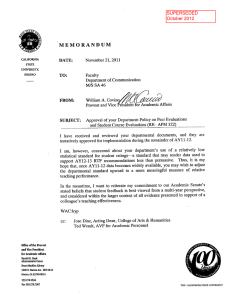
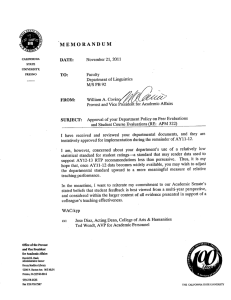
![[BRACKETS INCLUDE SUGGESTED INFORMATION THAT MAY BE INCREASED] DEPARTMENT OF FORESTRY](http://s2.studylib.net/store/data/013068471_1-cfecf471b59af83eb9fbee25e61f8411-300x300.png)
